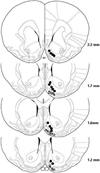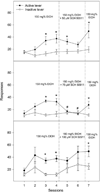The reinforcing effects of ethanol within the nucleus accumbens shell involve activation of local GABA and serotonin receptors
- PMID: 25922425
- PMCID: PMC4677478
- DOI: 10.1177/0269881115581982
The reinforcing effects of ethanol within the nucleus accumbens shell involve activation of local GABA and serotonin receptors
Abstract
Ethanol is reinforcing within the nucleus accumbens shell (NACsh), but the underlying mechanisms remain unclear. Ethanol can potentiate the function of the GABAA, GABAB, and serotonin-3 (5-HT3) receptors. Therefore, the current study tested the hypothesis that activation of these receptors would be involved in the reinforcing effects of ethanol in the NACsh. An intracranial self-administration (ICSA) procedure was used to assess the reinforcing effects of ethanol in the NACsh of alcohol preferring (P) rats. The ICSA consisted of seven sessions: four sessions to establish 150 mg% ethanol self-infusion into the NACsh; sessions 5 and 6 with co-infusion of ethanol plus one concentration of the GABAA antagonist bicuculline (10 or 100 µM), the GABAB antagonist SCH 50911 (50, 75 or 100 µM), or the 5-HT3 receptor antagonist zacopride (10 or 100 µM); and session 7 with 150 mg% ethanol alone. All groups self-infused ethanol into the NACsh and readily discriminated the active from inactive lever during the acquisition sessions. Co-infusion of 100 µM, but not 10 µM, bicuculline or zacopride significantly decreased active responses during sessions 5 and 6. Co-infusion of 75 µM, but not 50 or 100 µM, SCH 50911 significantly attenuated responses for ethanol. Overall, the results suggest that the reinforcing effects of ethanol in the NACsh may be modulated by activation of local GABAA, GABAB and 5-HT3 receptors.
Keywords: GABAA receptor; GABAB receptor; Intracranial self-administration; ethanol; nucleus accumbens; serotonin receptor.
© The Author(s) 2015.
Conflict of interest statement
The authors declare that there is no conflict of interest.
Figures




References
-
- Allan AM, Huidobro-Toro JP, Bleck V, Harris RA. Alcohol and the GABA receptor-chloride channel complex of brain. Alcohol Alcohol. 1987;(Suppl 1):643–646. - PubMed
-
- Aono Y, Saigusa T, Mizoguchi N, Iwakami T, Takada K, Gionhaku N, Oi Y, Ueda K, Koshikawa N, Cools AR. Role of GABAA receptors in the endomorphine-1, but not endomorphin-2, induced dopamine efflux in the nucleus accumbens of freely moving rats. Eur J Pharmacol. 2008;580:87–94. - PubMed
-
- Barnes JM, Barnes NM, Champaneria S, Costall B, Naylor RJ. Characterisation and autoradiographic localisation of 5-HT3 recognition sites identified with [3H]-(S)-zacopride in the forebrain of the rat. Neuropharmacology. 1990;29:1037–1045. - PubMed
-
- Bolser DC, Blythin DJ, Chapman RW, Eqan RW, Hey JA, Rizzo C, Kuo SC, Kreutner W. The pharmacology of SCH 50911: a novel, orally-active GABA-B receptor antagonist. J Pharmacol Exp Ther. 1995;274:1393–1398. - PubMed
-
- Bowery NG, Hudson AL, Price GW. GABAA and GABAB receptor site distribution in the rat central nervous system. Neuroscience. 1987;20:365–383. - PubMed
Publication types
MeSH terms
Substances
Grants and funding
LinkOut - more resources
Full Text Sources
Other Literature Sources
Miscellaneous

